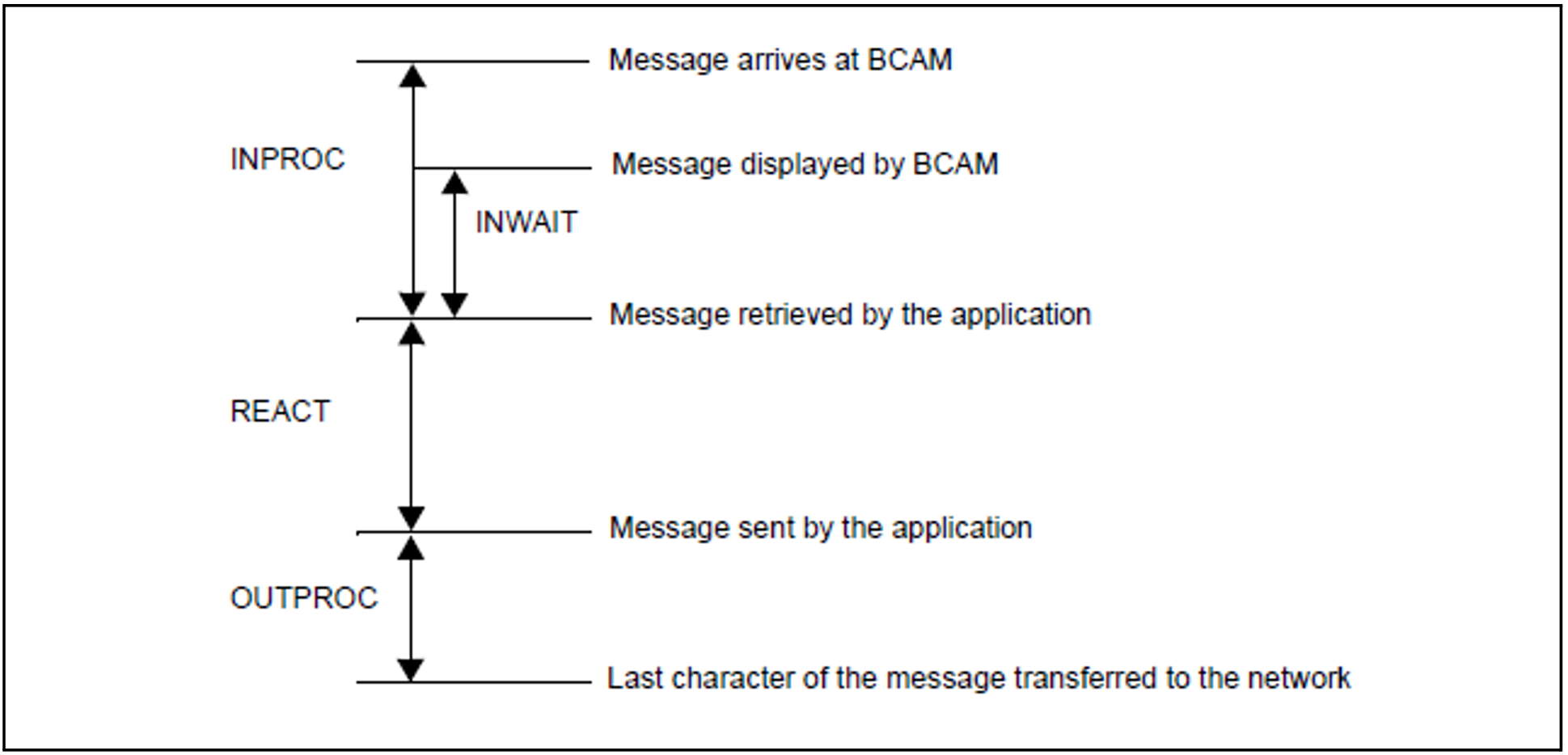The BCAM-CONNECTION monitoring program supplies monitored data for connections that are combined in connection sets. It provides monitored variables for DCAM applications (with NEA names) and socket applications (with port numbers) only. Information is recorded on INWAIT, REACT, INPROC and OUTPROC times.
The INWAIT time is defined as the time between the display of a BCAM message at an application and the retrieval of this message by the application.
The REACT time is defined as the time between an application’s send call and the receive call which immediately precedes it. If the send and receive calls are logically linked, then the REACT time can be seen as the time it takes for the application to respond. In dialog-oriented applications, each input is normally followed by the appropriate output.
The INPROC time is defined as the time between the arrival of a message at BCAM and the retrieval of this message by the application. The INPROC time includes the INWAIT time.
The OUTPROC time is defined as the time between a send call and the transfer of the last byte of a message to the network. Data transfer to the network may also be delayed by the receiving party.
Representation of time definitions
In addition, statistics are recorded on incoming and outgoing data (jobs, the volume of data, packets, etc.).
The SM2 administrator can use the SET-BCAM-CONNECTION-PARAMETERS and ADD-BCAM-CONNECTION-SET statements to define global and connection-specific monitoring parameters respectively.
The SET-BCAM-CONNECTION-PARAMETERS statement must be entered before the first ADD-BCAM-CONNECTION-SET statement.
BCAM keeps a connection open for up to 4 minutes even if a task has already closed the connection. From the SM2 viewpoint, too, such a connection is still open, but no further activity takes place on it.
It can also occur that a connection is rejected by the partner. No connection has been established. The number of connections of this type is determined and output.
Global parameters
Time statistics are recorded as an average value and bucket-specifically. The BUCKET parameters consist of a list of the maximum INWAIT, REACT, INPROC and OUTPROC times, arranged in order of magnitude. The ranges defined in these lists apply to all connection sets defined in the ADD-BCAM-CONNECTION-SET statement.
<integer 1 .. 99999> is an integer which defines a limit value. The number of limit values in this list implicitly determines the number of ranges. This may vary from list to list, but four limit values is the maximum.
The last value in the list of ranges specifies the overflow limit. All monitored variables that exceed this limit are included under the last range. The bucket parameters in BCAM can be specified by both SM2 and other applications. It is also possible to disable monitored data acquisition entirely.
The SET-BCAM-CONNECTION-PARAMETERS statement contains the *UNCHANGED operand value. This causes SM2 to leave the bucket parameters set in BCAM as they are, and to adopt these values for its own monitoring program definition.
If the SET-BCAM-CONNECTION-PARAMETERS statement is used to define alternative bucket parameters, then these will also be set in BCAM when you start the monitoring program. If you modify the bucket parameters in BCAM during the monitoring process, the new parameters will also apply to SM2.
If monitored data acquisition is disabled in BCAM during monitoring, SM2 will reenable it using the parameters defined in SM2.
Connection-specific parameters
A connection is defined by an NEA name or a port number, the type of connection, and the host name. A connection set is understood as a number of connections defined by specifying these objects.
The objects may be specified using
a fully qualified name (name)
a partially qualified name (name*)
or an unqualified name (*ANY, *LOCAL, *REMOTE, *BOTH)
Using an unqualified name may lead to fluctuations in the number of connections in a connection set during monitoring. The BCAM-CONNECTION screen shows the number of connections of the connection set which are currently being monitored. A connection set is defined by specifying a list of up to 16 name definitions. You can specify either NEA application names or port numbers, but not both.
You must also specify the type of connection:
*LOCAL | Only connections within the host |
Another distinguishing feature used to select connections is the names of the hosts between which the connection exists. It is possible to define up to 32 connection sets.
Examples of monitoring program definitions
Example 1
SET-BCAM-CONNECTION-PARAMETER
INWAIT-BUCKETS = *UNCHANGED,
REACT-BUCKETS = *UNCHANGED,
INPROC-BUCKETS = *UNCHANGED,
OUTPROC-BUCKETS = *UNCHANGED
ADD-BCAM-CONNECTION-SET
SET-NAME = setname1,
CONNECTION-SELECTION = *BY-NEA-NAME (
CONNECTION-NAME = *SPECIFIED (
LOCAL-APPLICATION = $DIALOG,
PARTNER-APPLICATION = *ANY)),
CONNECTION-TYPE = *REMOTE,
HOST-SELECTION = *SPECIFIED (
LOCAL-HOST-NAME = *LOCAL,
PARTNER-HOST-NAME = hostname1)
START-MEASUREMENT-PROGRAM TYPE = *BCAM-CONNECTION
In these statements, the monitoring parameters set in BCAM are transferred. A connection set is defined which records all connections with the name type NEA and the local application name $DIALOG. The connections are remote and lead to the specified hosts.
Example 2
REMOVE-BCAM-CONNECTION-SET SET-NAME = *ALL
SET-BCAM-CONNECTION-PARAMETER
ADD-BCAM-CONNECTION-SET
SET-NAME = setname2,
CONNECTION-SELECTION = *BY-PORT-NUMBER(
PORT-NUMBER = *SPECIFIED (
LOCAL-PORT-NUMBER = 5000,
PARTNER-PORT-NUMBER = *ANY)),
CONNECTION-TYPE = *BOTH,
HOST-SELECTION = *SPECIFIED (
LOCAL-HOST-NAME = *LOCAL,
PARTNER-HOST-NAME = hostname2)
CHANGE-MEASUREMENT-PROGRAM TYPE = *BCAM-CONNECTION
These statements end the current monitoring process and restart it using new parameters. The bucket parameters are set to their default values. A connection set is defined which records all connections with the local port number 5000 and which lead to the specified host.

